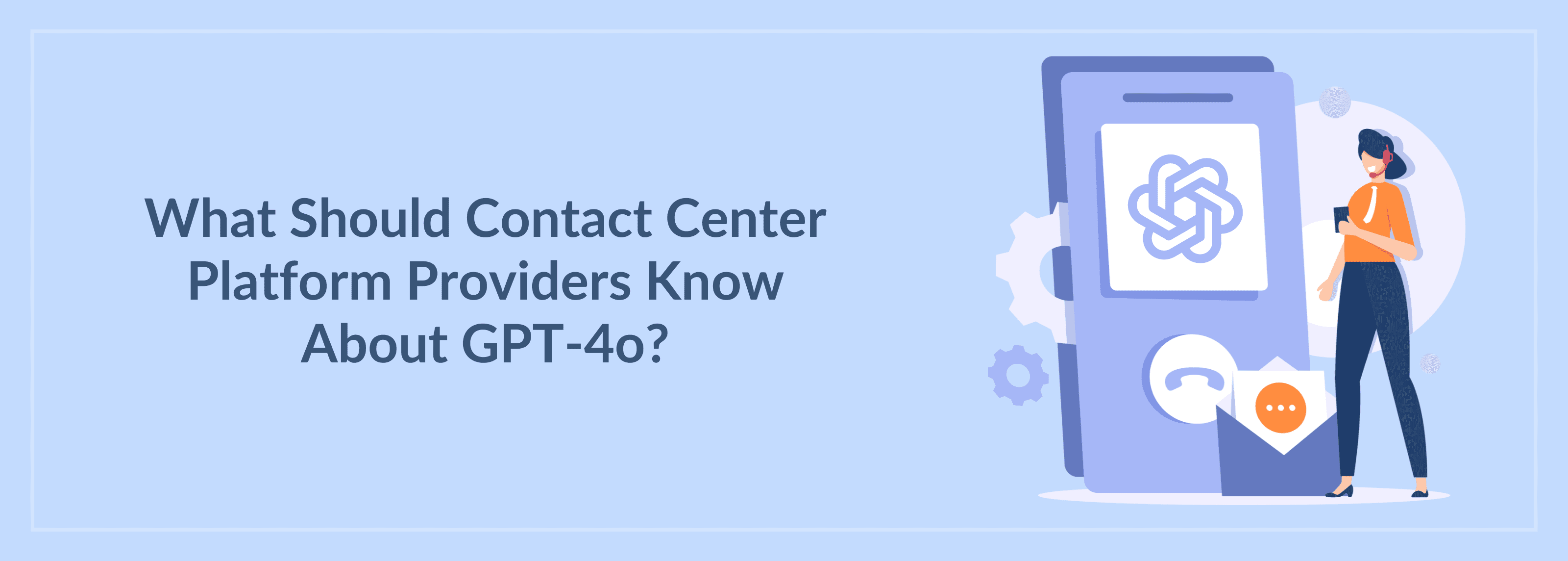What Do Contact Center Platform Providers Need to Know About GPT-4o?
OpenAI recently unveiled the latest iteration of its flagship large language model (LLM), GPT-4o. This new model stands out due to its multimodal capabilities, enabling it to process and reason across audio, vision, and text in real-time.
The launch of GPT-4o marks a significant advancement in artificial intelligence, particularly for contact center platforms.
However, with such advancements come critical considerations for platform providers.
Here’s what you need to know and how you can prepare for the future.
The Game-Changing Capabilities of GPT-4o
GPT-4o’s ability to handle multiple modalities almost instantly represents a leap forward in AI capabilities.
Traditionally, creating pipelines for tasks like speech-to-text and real-time translation has been fraught with challenges, such as high processing times and integration complexities.
GPT-4o promises to simplify these processes, making sophisticated AI features more accessible than ever.
There is a general feeling in the industry that the advancements brought by GPT-4o have rendered hundreds of millions of dollars of R&D in Contact Center AI agents obsolete.
We know that earlier versions of LLMs like ChatGPT have already displaced many manually engineered natural language processing (NLP) models designed to gauge intent and sentiment.
Key Considerations for Contact Center Platform Providers
1. Integrating Multimodal Capabilities
One of the primary advancements of GPT-4o is its ability to handle text, audio, and vision in real time.
Contact center platforms should look to integrate these multimodal capabilities to enhance the customer experience.
This means developing interfaces that seamlessly support real-time translation, voice recognition, and image analysis.
For instance, integrating real-time translation can eliminate language barriers instantly, allowing agents to interact with customers in their native language without the awkward delays of traditional translation systems.
2. Enhancing Real-Time Interactions
The ability to process and analyze data in real time opens up new possibilities for customer interactions.
Consider the example of real-time sentiment analysis: GPT-4o can gauge customer emotions during interactions and provide agents with actionable insights to tailor their responses accordingly.
This can improve customer satisfaction and increase the likelihood of resolving issues on the first contact.
3. Automating Complex Workflows
GPT-4o’s advanced capabilities enable the automation of complex workflows.
For contact centers, tasks such as call routing, information retrieval, and even complex problem-solving can be automated to a higher degree.
This not only frees up agents to handle more intricate issues but also ensures that customers receive prompt and accurate responses.
4. Ensuring Data Security and Privacy
With the integration of sophisticated AI models like GPT-4o, ensuring data security and privacy becomes paramount.
Contact center platforms must implement robust security measures to protect sensitive customer information.
This includes secure data transmission protocols, rigorous access controls, and regular security audits to prevent data breaches.
While looking at AI advancements like GPT-4o, you have to guard yourself against potential pitfalls.
What Are the Potential Pitfalls to Guard Against?
1. Over-Reliance on AI
While AI can significantly enhance contact center operations, over-reliance on technology without maintaining a human touch can be detrimental.
Customers still value human interactions, especially for complex or sensitive issues. Platform providers should strive for a balanced approach where AI assists and augments human agents rather than replacing them entirely.
2. Integration Challenges
Integrating new AI capabilities into existing systems can be complex and resource-intensive.
Platform providers should plan for thorough testing and gradual implementation to ensure a smooth transition. This includes training agents and technical staff to utilize the new features effectively.
3. Maintaining AI Accuracy
AI models like GPT-4o are powerful but not infallible. Ensuring that the AI provides accurate and context-aware responses is crucial.
Continuous monitoring, regular updates, and fine-tuning of the AI model based on real-world interactions are essential to maintain high levels of accuracy and relevance.
4. Ethical and Bias Concerns
AI models like GPT-4o are trained on vast amounts of data, which can inadvertently encode biases in the training data.
Contact center platform providers must be vigilant in identifying and mitigating bias to ensure fair and equitable treatment of all customers.
This includes regularly auditing AI algorithms for bias and implementing measures to address disparities.
5. Scalability Challenges
While AI-driven solutions offer immense potential, they also pose scalability challenges, especially for large-scale contact centers with high call volumes.
Platform providers must ensure that their infrastructure can support the increased computational demands of AI-powered features without sacrificing performance or reliability.
This may involve investing in robust cloud-based solutions and optimizing resource allocation to handle peak loads effectively.
6. User Adoption and Training
Introducing new AI capabilities into the contact center environment requires adequate training and support for agents and administrators.
Platform providers must offer comprehensive training programs to familiarize users with the new features and ensure proficiency.
Additionally, ongoing support and troubleshooting resources are essential to address any issues that arise during implementation and operation.
7. Regulatory Compliance
Using AI in contact centers may raise regulatory compliance concerns regarding data privacy and security.
Platform providers must adhere to relevant regulations such as GDPR, CCPA, and HIPAA to ensure that customer data is handled in accordance with legal requirements.
This may involve implementing robust data protection measures, obtaining appropriate consent for data processing, and maintaining detailed records of AI-driven interactions for auditing purposes.
The release of GPT-4o heralds a new era for contact center platform providers. By integrating multimodal capabilities, enhancing real-time interactions, and automating workflows, providers can significantly improve customer experiences and operational efficiency.
However, it is equally important to guard against potential pitfalls such as over-reliance on AI, integration challenges, and maintaining AI accuracy.
As we move forward, we should focus on developing robust back-end integrations, customizing the AI model to meet specific needs, and ensuring secure and seamless operations.
By doing so, contact center platform providers can harness the full potential of GPT-4o and lead the way in transforming customer interactions.
